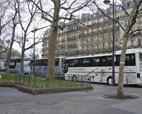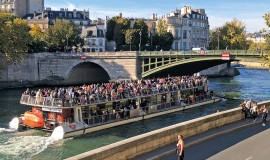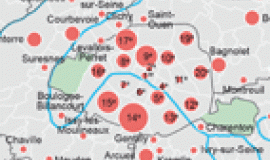
Ile-de-France, with its 67 million overnight stays in hotels in 2013, holds first place as a tourist destination in France. The region accommodates half France’s recorded, foreign arrivals and overnight stays r(respectively 46% and 53%). It offers approximately 1/4 of the nation’s hotel accommodation, almost 40% of which is top-of-the-range, and concentrates 1/3 of the country’s jobs in the tourism sector.
Behind these positive elements and trends however, great changes have been taking place within tourism. the transformations in tourist activities are linked to the shift in the centre of gravity of the zones from which they come. Members of the well-off classes of emerging economies are greatly increasing among tourists arriving in the region. They bring with them new touristic behavior patterns : among these newcomers to tourism, those who opt for visiting by coach do not particularly desire to stay in the heart of the conurbation. Greater Paris is therefore filling up with reception structures for accommodating groups and their coaches. For these fresh arrivals on the tourist scene shopping has become a high priority, generating an intense influx in certain shopping areas. Nevertheless the ritual visits of the big museums have not been abandoned by these new tourists. They are reinforced by the resistance of tourists from “old Europe” and also the United States who ensure that the academic routes of tourism endure.
A number of big transformations have marked the ten years between the two series of surveys:
- the proportion of foreign coaches increased from 49% in 2001 to 60% in 2013-2014, to the detriment of vehicles registered in the Ile-de-France. The percentage of vehicles registered in the rest of France remained stable.
- a large increase of tourists of Asian origins: using group coach transport: 21% of groups in 2001, 50% in 2013-2014, counterbalanced by a decrease of Europeans.
- accommodation for groups, has gradually moved from the centre of the metropolis towards its outskirts: Greater Paris accommodates 38% of groups (10% in 2001), Paris 33% (64% in 2001);
- a rise among groups choosing top-of-the-range hotels: 4 (or more) star hotels now make up 45% of selected options (19% in 2001). This choice is made primarily by the Japanese and American clientele who prefer to stay within Paris proper (which accommodates 60% of the regional hotel capacity in this section);
- the rate of visits has accelerated (3,7 per day compared with 2,9 in 2001) and attendance has increased at the Louvre Museum, the Arc de Triomphe, and the Estate of Versailles. The Tour Montparnasse, which didn’t figure at all in the 2001 surveys, is now among the Top 14 sites accommodating the greatest number of coaches on the days that the surveys were carried out. However, stops at the Eiffel Tower, Nôtre-Dame-de-Paris and Montmartre declined sharply between 2001 and 2013-2014;
- the “shopping” component is now firmly integrated into group circuits. A particular favourite among the Asian clientele, this activity increases at the same momentum as the rate of their visits goes up. The big department stores benefit particularly from this influx.



